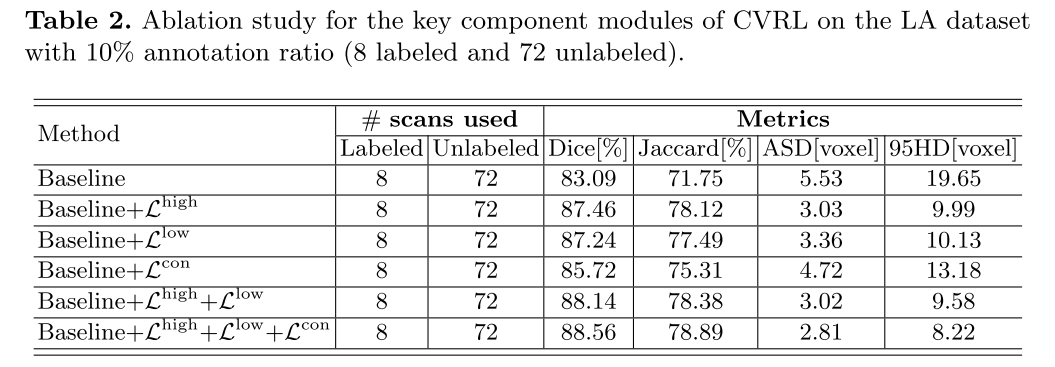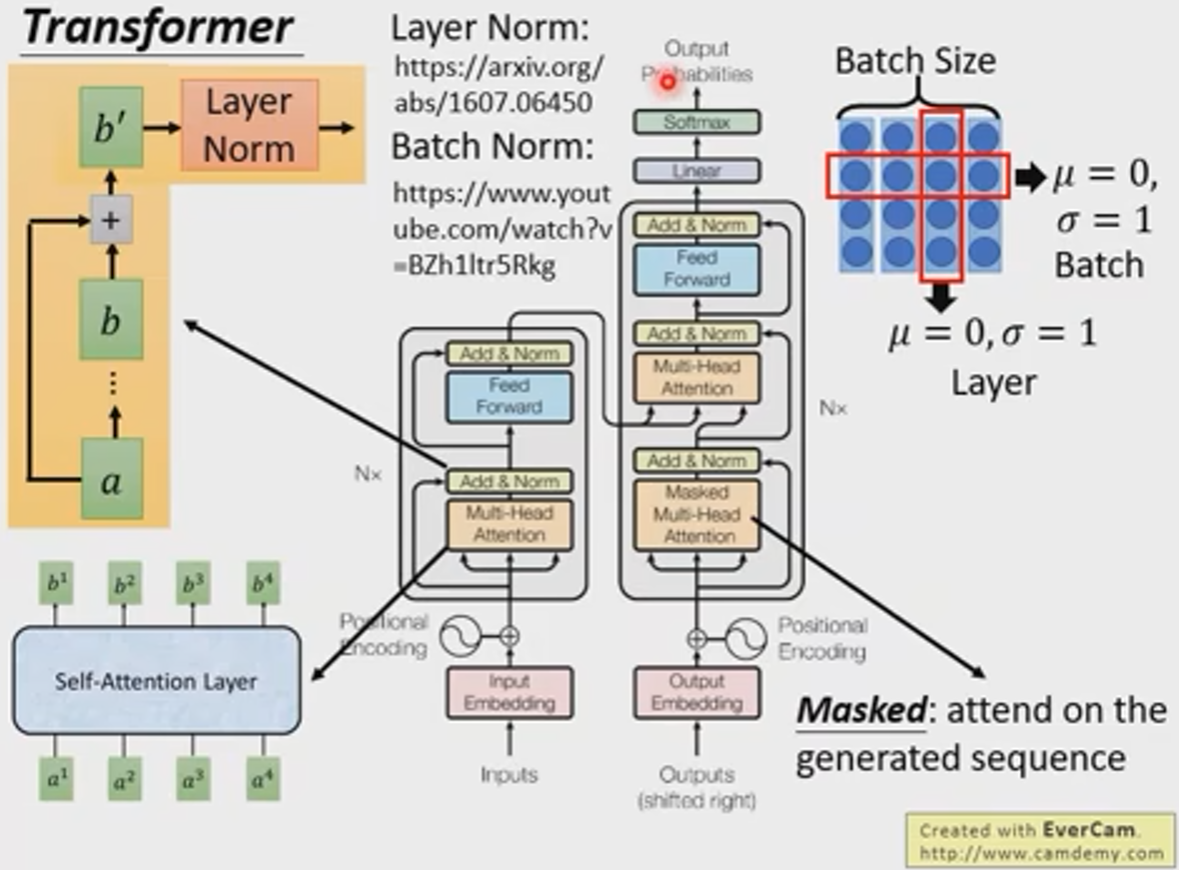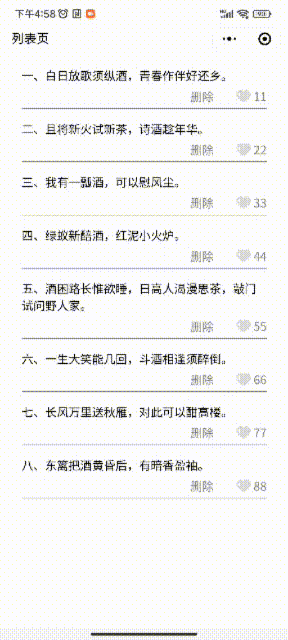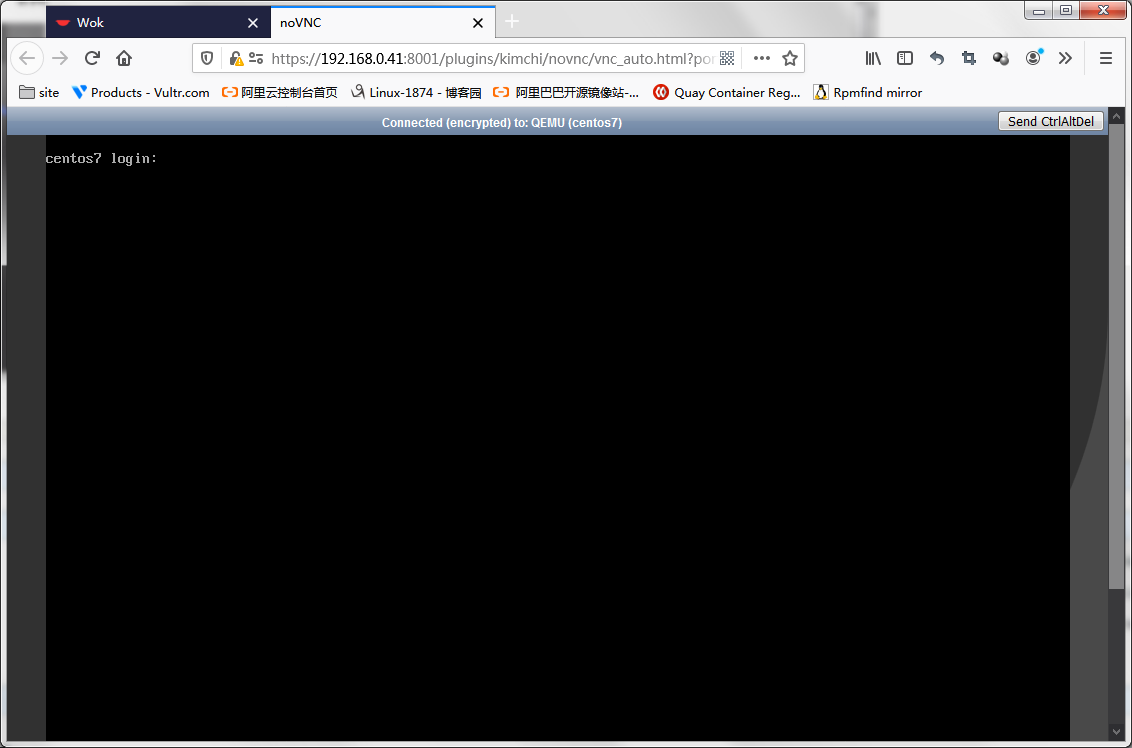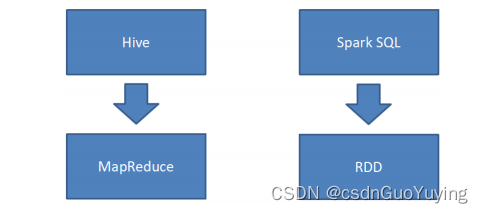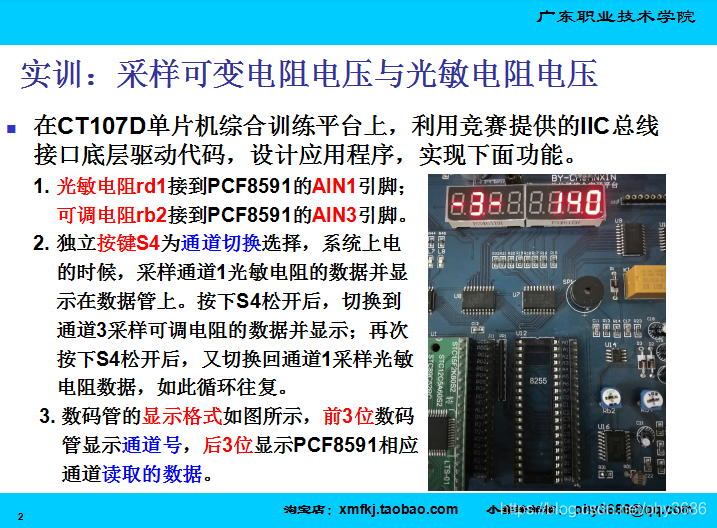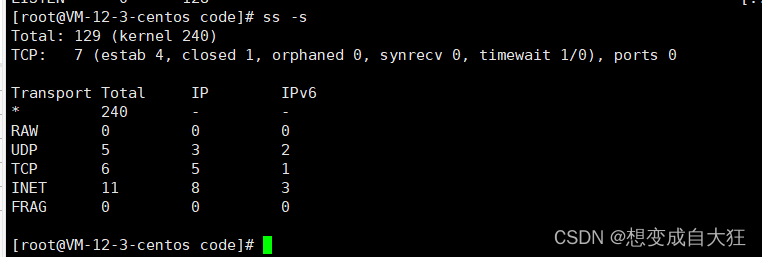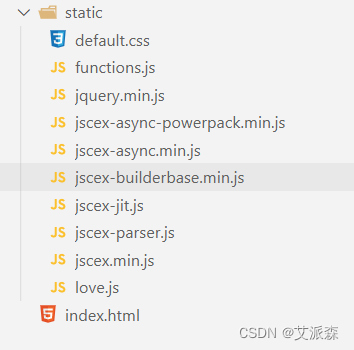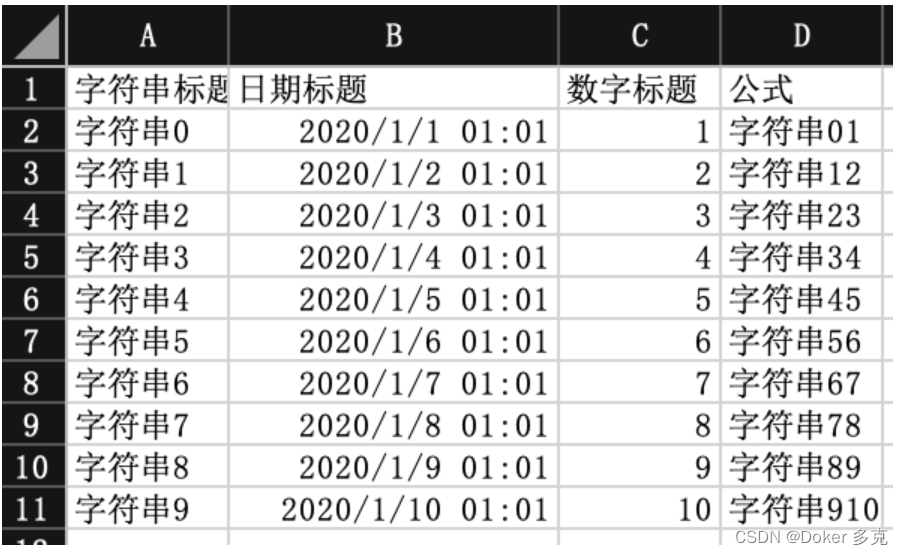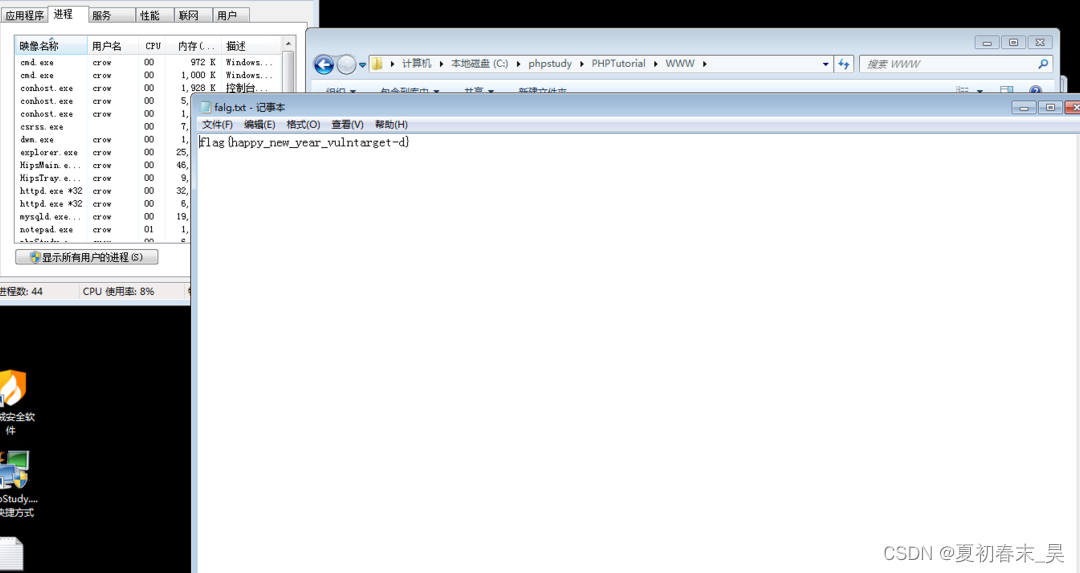2.2.3、Optimize
2.2.3.1、SQL
3.3.1.1、RB
1、Join选择
在Hadoop中,MR使用DistributedCache来实现mapJoin。即将小文件存放到DistributedCache中,然后分发到各个Task上,并加载到内存中,类似于Map结构,然后借助于Mapper的迭代机制,遍历大表中的每一条记录,并查找是否在小表中,如果不在则省略。
而Spark是使用广播变量的方式来实现MapJoin.
2、谓词下推
3、列裁剪
4、常量替换
5、分区剪枝
3.3.1.2、CBO
开启cbo之后(通过配置spark.sql.cbo.enabled),有以下几个优化点:
1、Build选择

2、优化Join类型

3、优化多Join顺序

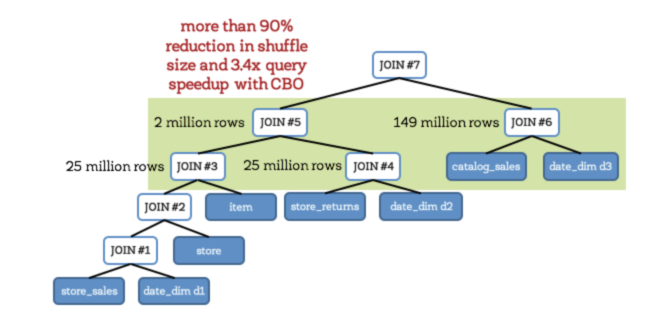
3.3.1.3、AE
3.3.1.3.1、Auto Setting The Shuffle Partition Number
Property Name | Default | Meaning |
spark.sql.adaptive.enabled | false | 设置为true,开启自适应机制 |
spark.sql.adaptive.minNumPostShufflePartitions | 1 | 自适应机制下最小的分区数,可以用来控制最小并行度 |
spark.sql.adaptive.maxNumPostShufflePartitions | 500 | 自适应机制下最大的分区数,可以用来控制最大并行度 |
spark.sql.adaptive.shuffle.targetPostShuffleInputSize | 67108864 | 动态reducer端每个Task最少处理的数据量. 默认为 64 MB. |
spark.sql.adaptive.shuffle.targetPostShuffleRowCount | 20000000 | 动态调整每个task最小处理 20000000条数据。该参数只有在行统计数据收集功能开启后才有作用 |
3.3.1.3.2、Optimizing Join Strategy at Runtime
Property Name | Default | Meaning |
spark.sql.adaptive.join.enabled | true | 运行过程是否动态调整join策略的开关 |
spark.sql.adaptiveBroadcastJoinThreshold | equals to spark.sql.autoBroadcastJoinThreshold | 运行过程中用于判断是否满足BroadcastJoin条件。如果不设置,则该值等于 spark.sql.autoBroadcastJoinThreshold. |
3.3.1.3.3、Handling Skewed Join
Property Name | Default | Meaning |
spark.sql.adaptive.skewedJoin.enabled | false | 运行期间自动处理倾斜问题的开关 |
spark.sql.adaptive.skewedPartitionFactor | 10 | 如果一个分区的大小大于所有分区大小的中位数而且大于spark.sql.adaptive.skewedPartitionSizeThreshold,或者分区条数大于所有分区条数的中位数且大于spark.sql.adaptive.skewedPartitionRowCountThreshold,那么就会被当成倾斜问题来处理 |
spark.sql.adaptive.skewedPartitionSizeThreshold | 67108864 | 倾斜分区大小不能小于该值 |
spark.sql.adaptive.skewedPartitionRowCountThreshold | 10000000 | 倾斜分区条数不能小于该值 |
spark.shuffle.statistics.verbose | false | 启用后MapStatus会采集每个分区条数信息,用来判断是否倾斜并进行相应的处理 |
2.2.3.2、Compute
2.2.3.2.1、Dynamic Executor Allocation
2.2.3.2.2、Paralliesm
2.2.3.2.3、Data Skew/Shuffle
其除了手段和Spark文章中提到的倾斜一样,这里不再叙述
2.2.3.2.4、Properties
更多配置见
Property Name | Default | Meaning |
spark.sql.inMemorycolumnarStorage.compressed | true | 内存中列存储压缩 |
spark.sql.codegen | false | 设置为true,可以为大型查询快速编辑创建字节码 |
spark.sql.inMemoryColumnarStorage.batchSize | 10000 | 默认列缓存大小为10000,增大该值可以提高内存利用率,但要避免OOM问题 |
spark.sql.files.maxPartitionBytes | 134217728 (128 MB) | The maximum number of bytes to pack into a single partition when reading files. This configuration is effective only when using file-based sources such as Parquet, JSON and ORC. |
spark.sql.files.openCostInBytes | 4194304 (4 MB) | The estimated cost to open a file, measured by the number of bytes could be scanned in the same time. This is used when putting multiple files into a partition. It is better to over-estimated, then the partitions with small files will be faster than partitions with bigger files (which is scheduled first). This configuration is effective only when using file-based sources such as Parquet, JSON and ORC. |
spark.sql.files.minPartitionNum | Default Parallelism | The suggested (not guaranteed) minimum number of split file partitions. If not set, the default value is `spark.default.parallelism`. This configuration is effective only when using file-based sources such as Parquet, JSON and ORC. |
spark.sql.broadcastTimeout | 300 | Timeout in seconds for the broadcast wait time in broadcast joins |
spark.sql.autoBroadcastJoinThreshold | 10485760 (10 MB) | Configures the maximum size in bytes for a table that will be broadcast to all worker nodes when performing a join. By setting this value to -1 broadcasting can be disabled. Note that currently statistics are only supported for Hive Metastore tables where the command ANALYZE TABLE <tableName> COMPUTE STATISTICS noscan has been run. |
spark.sql.shuffle.partitions | 200 | Configures the number of partitions to use when shuffling data for joins or aggregations |
spark.sql.sources.parallelPartitionDiscovery.threshold | 32 | Configures the threshold to enable parallel listing for job input paths. If the number of input paths is larger than this threshold, Spark will list the files by using Spark distributed job. Otherwise, it will fallback to sequential listing. This configuration is only effective when using file-based data sources such as Parquet, ORC and JSON. |
spark.sql.sources.parallelPartitionDiscovery.parallelism | 10000 | Configures the maximum listing parallelism for job input paths. In case the number of input paths is larger than this value, it will be throttled down to use this value. Same as above, this configuration is only effective when using file-based data sources such as Parquet, ORC and JSON. |
spark.sql.adaptive.coalescePartitions.enabled | true | When true and spark.sql.adaptive.enabled is true, Spark will coalesce contiguous shuffle partitions according to the target size (specified by spark.sql.adaptive.advisoryPartitionSizeInBytes), to avoid too many small tasks |
spark.sql.adaptive.coalescePartitions.minPartitionNum | Default Parallelism | The minimum number of shuffle partitions after coalescing. If not set, the default value is the default parallelism of the Spark cluster. This configuration only has an effect when spark.sql.adaptive.enabled and spark.sql.adaptive.coalescePartitions.enabled are both enabled. |
spark.sql.adaptive.coalescePartitions.initialPartitionNum | (none) | The initial number of shuffle partitions before coalescing. If not set, it equals to spark.sql.shuffle.partitions . This configuration only has an effect when spark.sql.adaptive.enabled and spark.sql.adaptive.coalescePartitions.enabled are both enabled. |
spark.sql.adaptive.advisoryPartitionSizeInBytes | 64 MB | The advisory size in bytes of the shuffle partition during adaptive optimization (when spark.sql.adaptive.enabled is true). It takes effect when Spark coalesces small shuffle partitions or splits skewed shuffle partition. |
spark.sql.adaptive.localShuffleReader.enabled | true | 开启自适应执行后,spark会使用本地的shuffle reader读取shuffle数据。这种情况只会发生在没有shuffle重分区的情况 |
spark.sql.adaptive.skewJoin.enabled | true | When true and spark.sql.adaptive.enabled is true, Spark dynamically handles skew in sort-merge join by splitting (and replicating if needed) skewed partitions. |
spark.sql.adaptive.skewJoin.skewedPartitionFactor | 5 | A partition is considered as skewed if its size is larger than this factor multiplying the median partition size and also larger than spark.sql.adaptive.skewJoin.skewedPartitionThresholdInBytes. |
spark.sql.adaptive.skewJoin.skewedPartitionThresholdInBytes | 256MB | A partition is considered as skewed if its size in bytes is larger than this threshold and also larger than spark.sql.adaptive.skewJoin.skewedPartitionFactor multiplying the median partition size. Ideally this config should be set larger than spark.sql.adaptive.advisoryPartitionSizeInBytes 、. |
spark.sql.optimizer.maxIterations | 100 | The max number of iterations the optimizer and analyzer runs |
spark.sql.optimizer.inSetConversionThreshold | 10 | The threshold of set size for InSet conversion |
spark.sql.inMemoryColumnarStorage.partitionPruning | true | When true,enable partition pruning for in-memory columnar tables |
spark.sql.inMemoryColumnarStorage.enableVectorizedReader | true | Enables vectorized reader for columnar caching |
spark.sql.columnVector.offheap.enabled | true | When true, use OffHeapColumnVector in ColumnarBatch. |
spark.sql.join.preferSortMergeJoin | true | When true, prefer sort merge join over shuffle hash join |
spark.sql.sort.enableRadixSort | true | When true, enable use of radix sort when possible. Radix sort is much faster but requires additional memory to be reserved up-front. The memory overhead may be significant when sorting very small rows (up to 50% more in this case) |
spark.sql.limit.scaleUpFactor | 4 | Minimal increase rate in number of partitions between attempts when executing a take on a query. Higher values lead to more partitions read. Lower values might lead to longer execution times as more jobs will be run |
spark.sql.hive.advancedPartitionPredicatePushdown.enabled | true | When true, advanced partition predicate pushdown into Hive metastore is enabled |
spark.sql.subexpressionElimination.enabled | true | When true, common subexpressions will be eliminated |
spark.sql.caseSensitive | false | Whether the query analyzer should be case sensitive or not. Default to case insensitive. It is highly discouraged to turn on case sensitive mode |
spark.sql.crossJoin.enabled | false | When false, we will throw an error if a query contains a cartesian product without explicit CROSS JOIN syntax. |
spark.sql.files.ignoreCorruptFiles | false | Whether to ignore corrupt files. If true, the Spark jobs will continue to run when encountering corrupted files and the contents that have been read will still be returned. |
spark.sql.files.ignoreMissingFiles | false | Whether to ignore missing files. If true, the Spark jobs will continue to run when encountering missing files and the contents that have been read will still be returned. |
spark.sql.files.maxRecordsPerFile | 0 | Maximum number of records to write out to a single file.If this value is zero or negative, there is no limit. |
spark.sql.cbo.enabled | false | Enables CBO for estimation of plan statistics when set true. |
spark.sql.cbo.joinReorder.enabled | false | Enables join reorder in CBO |
spark.sql.cbo.joinReorder.dp.threshold | 12 | The maximum number of joined nodes allowed in the dynamic programming algorithm |
spark.sql.cbo.joinReorder.card.weight | 0.7 | The weight of cardinality (number of rows) for plan cost comparison in join reorder: rows * weight + size * (1 - weight). |
spark.sql.cbo.joinReorder.dp.star.filter | false | Applies star-join filter heuristics to cost based join enumeration |
spark.sql.cbo.starSchemaDetection | false | When true, it enables join reordering based on star schema detection |
spark.sql.cbo.starJoinFTRatio | 0.9 | Specifies the upper limit of the ratio between the largest fact tables for a star join to be considered |
spark.sql.windowExec.buffer.in.memory.threshold | 4096 | Threshold for number of rows guaranteed to be held in memory by the window operator |
2.2.3.3、Storage
2.2.3.3.1、Small File
小文件的危害就不再叙述了,这个时候就要思考什么时候会产生小文件。其产生的地方有:
1、源头:如果原始文件就存在小文件,那么就需要先进行合并,然后再计算,避免产生大量的task造成资源浪费
2、计算过程中:这个时候就要结合实际的数据量大小和分布,以及分区数进行调整。
3、写入:写入文件的数量跟reduce/分区的个数有关系,可以根据实际的数据量进行调整并行度或者配置自动合并
2.2.3.3.2、Cold And Hot Data
2.2.3.3.3、Compress And Serializable
1、文件采用合适的存储类型以及压缩格式
2、使用合适高效的序列化器,如kryo
Property Name | Default | Meaning |
spark.sql.parquet.compression.codec | snappy | parquet存储类型文件的压缩格式,默认为snappy |
spark.sql.sources.fileCompressionFactor | 1.0 | When estimating the output data size of a table scan, multiply the file size with this factor as the estimated data size, in case the data is compressed in the file and lead to a heavily underestimated result |
spark.sql.parquet.mergeSchema | false | When true, the Parquet data source merges schemas collected from all data files, otherwise the schema is picked from the summary file or a random data file if no summary file is available |
spark.sql.parquet.respectSummaryFiles | false | When true, we make assumption that all part-files of Parquet are consistent with summary files and we will ignore them when merging schema. Otherwise, if this is false, which is the default, we will merge all part-files. This should be considered as expert-only option, and shouldn't be enabled before knowing what it means exactly |
spark.sql.parquet.binaryAsString | false | Some other Parquet-producing systems, in particular Impala and older versions of Spark SQL, do not differentiate between binary data and strings when writing out the Parquet schema. This flag tells Spark SQL to interpret binary data as a string to provide compatibility with these systems |
spark.sql.parquet.filterPushdown | true | Enables Parquet filter push-down optimization when set to true |
spark.sql.parquet.columnarReaderBatchSize | 4096 | The number of rows to include in a parquet vectorized reader batch. The number should be carefully chosen to minimize overhead and avoid OOMs in reading data. |
2.2.3.4、Other
2.2.3.4.1、Closed Loop FeedBack
2.2.3.4.1.1、实时运行信息分析
2.2.3.4.1.2、运行信息离线统计分析
高频表、列统计,错误信息汇总,策略生效情况记录等。

